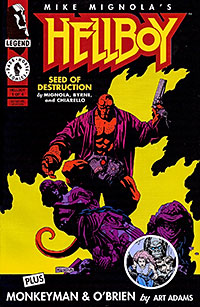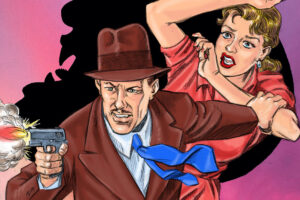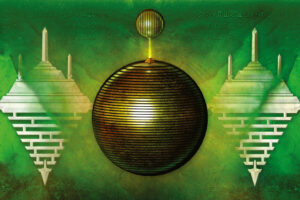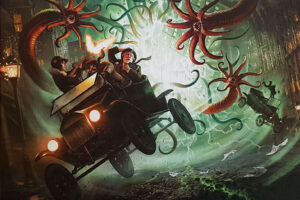 Hellboy, World’s Greatest Paranormal Investigator, is a comic-book series that in the last 20 years has spawned a whole universe of stories and series, along with animated stories and two movies.
Hellboy, World’s Greatest Paranormal Investigator, is a comic-book series that in the last 20 years has spawned a whole universe of stories and series, along with animated stories and two movies.
Created by artist/writer Mike Mignola, the series has several pulp influences, including inspiration from H.P. Lovecraft, Clark Ashton Smith, and Manly Wade Wellman.
Hellboy is an actual demon from Hell, who was summoned to Earth as an infant by Nazi occultists lead by Rasputin in 1944. Thanks to being raised by humans and having free will, he is not evil. Instead he is a key member of the Bureau of Paranormal Research and Defense, which includes other “creatures” who fight the forces of occult evil. He has a right hand made of stone, something which plays a big part in many of the stories.
It was how Hellboy and his stories breaks from what we expect that is a big attraction for me, as well as the other elements I saw in them. We see Hellboy horrified and disgusted by the evil that he finds. And when Rasputin tries to use him and order him around, to have him tell Rasputin to go to hell and refuse is great.
At first, Hellboy stories were either standalone or short mini-series. Some stories dealt with learning more about the origin and destiny of Hellboy. These stories take inspiration from Lovecraft and Smith, laying down a history of the world that goes back to creation and runs through pre-human civilizations such as Hyperborea and Lemuria as well as certain beings who are trying to “break through” and take back the world (similar to themes in Lovecraft’s “Cthulhu mythos”). Other stories, usually the stand-alone ones, often take their inspiration from Wellman, and tell of Hellboy confronting occult threats, usually on his wanderings (in particular “The Crooked Man” and other stories done by artist Richard Corben).
Eventually, many of the stories, especially the mini-series, started to reveal more about Hellboy and tie in to a larger storyline that is still being revealed.
 Hellboy was more likely to confront occult horrors from various cultures around the world, along with the “beings from the outer void,” rather then more prosaic monsters. Werewolves were rare, vampires exist in the Hellboy Universe but most kept themselves hidden from the world as shown by some stories. Beings from the world of faerie are also shown to exist.
Hellboy was more likely to confront occult horrors from various cultures around the world, along with the “beings from the outer void,” rather then more prosaic monsters. Werewolves were rare, vampires exist in the Hellboy Universe but most kept themselves hidden from the world as shown by some stories. Beings from the world of faerie are also shown to exist.
The Bureau — an independent organization at first, but later a U.N. agency — has various agents who confront the occult. This also include, or have included, humans with powers like Liz Sherman (pyrokinetic) and ageless mummy Panya, along with others like Abe Sapien, an amphibious humanoid, and Roger, a homunculus. The Bureau has had its own series for some time, and Abe has his own spin-off series.
Other spin-off series have been set in the past, and will be more fully covered in other postings. These include Victorian occult investigator Sir Edmund Gray- Witchfinder, pulp hero Lobster Johnson, and the Vril-powered suit Sledgehammer in WWII.
Hellboy has had two movies done by Guillermo del Toro. Sadly, while the look of the movies was great, and Ron Perlman was probably the best choice for Hellboy, Del Toro made alterations to the character and universe that I didn’t care for, as they removed stuff that I thought made Hellboy interesting and unique. One thing I thought was interesting was that Hellboy was known by everyone and pretty much accepted, but Del Toro made the Bureau secret and Hellboy unknown to the public at large. Also added was a romance between Hellboy and Liz. I would have preferred Mike Mignola’s Hellboy rather than Del Toro’s.
Hellboy has also gotten several novels and anthologies series, over a dozen.
The Hellboy series has been collected in over a dozen trade paperback volumes. Most are numbered, but a few are standalone. Some of the recent Hellboy stories have not yet been collected. The other series have their own collections. While many stories stand alone, as there are underlying themes and secondary storylines, it’s probably best to start with the volumes in order.
If you like a different take on occult investigators, Hellboy and his universe of characters is one to check out. I’ve enjoyed the series for many years.




I remember leafing through the first Hellboy trade paperback in a bookstore, and seeing that the book was dedicated to the memory of H.P. Lovecraft and Jack Kirby. I’ve been hooked ever since.
What a superb overview of the character and his career! Hard to believe Hellboy’s only been around for 20 years, with such a wide-ranging, multimedia set of offshoots. I’d forgotten how rich and complex his universe is.
And I agree that, for all his talent, Del Toro somehow didn’t quite “get” the character. In the comic, as you say, “Hellboy was known by everyone and pretty much accepted,” and treated by Mike Mignola as if he expected readers to react in a similarly accepting fashion to this demon-who-rejected-his-nature (for those not in the know, those goggle-like things on his forehead are the stumps of the horns he’s sawed off).
Yet in the first movie, Del Toro apparently feared audiences would not easily take to the character, and invented an intermediary, a humdrum chap (FBI guy, as I recall) who took up ‘way too much screen time, through whose eyes we’d observe and grow to respect Hellboy.
The Lovecraft influence is clearly apparent. Manly Wade Wellman’s is evident in Mignola’s taste for employing folk tales and their creatures (like the unsettling, surreal Japanese version of vampires) in his stories. But I’ve not read enough Clark Ashton Smith — though his brilliance is self-evident — to pick out where he shaped Mignola’s writing.
Hellboy is a great character; I’ve been along for the ride since his earliest adventures, when Mignola lacked confidence in his scripting skills and asked friend John Byrne to help out with dialogue.
It’s surprising that Mignola’s rendering approach — starkly stylized, often featuring montages of static scenes to set mood — has been as successful as it has been over the years. One would think he’d have ended up an “artist’s artist,” like Alex Toth more appreciated by other creators and a proportionately few discerning fans than a hit with a larger audience.
His “Hellboyverse” has been, as you’ve described, prolific in generating fascinating characters, storylines, and miniseries spin-offs, as well as the long-running “B.P.R.D.,” which despite the clunky title has been a splendid comic, fortunate to have featured Guy Davis doing art for most of its run. (Looking at some of Davis’ amazingly thought-out settings — from starkly fortified military base to decaying Victorian manse — I thought at the time Davis would make a helluva production designer in the movies. As it turned out, Del Toro tapped him years later to create the look of the massive monsters in “Pacific Rim,” which are recognizably Davis-ish.)
Aside from the obviously “pulp hero” Lobster Johnson, can’t recall overt nods to the pulps in “Hellboy.” Yet pulp flows through the veins of this body of work.
As the “What is Pulp Fiction? And we don’t mean the movie!” entry at http://www.vintagelibrary.com/pulpfiction/introduction/What-Is-Pulp-Fiction.php notes, “Bigger-than-life heroes, pretty girls, exotic places, strange and mysterious villains” were featured in the pulps (as we well know), along with fast-paced action, hyperdramatic threats and situations.
And so it is with the various Hellboy titles, distinguished from the superhero fare which prevails in the marketplace these days by their combination of moody horror, supernatural threats, and slam-bang action.
Much as Conan has been (unjustly) said to be too stupid to do anything but punch, hack, and slash his way out of danger, Hellboy likewise reacts to threats not with ratiocination, but fisticuffs. He’s a gruff, no-nonsense type, as the cigars denote. If a villain sets forth a lengthy justifications of his actions, Hellboy is apt to burst out with the equivalent of “That’s enough of your crap!”, and punch his daylights out.
But then again, HB’s formative years were the WW II era, where a similarly hard-nosed attitude prevailed.
For those interested in the comics, I greatly recommend the trade paperbacks! Many a time I was dismayed — after having faithfully purchased the magazine-format issues — to find the collections would have brand-new additions unavailable elsewhere, irresistibly juicy as an entire story illustrated by P. Craig Russell, making me buy the book just for that…
(By the way, a pleasure to have met you at the recent Pulp AdventureCon in Ft. Lauderdale…)